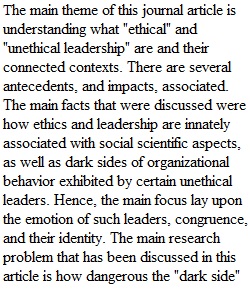


Q To access the assignment instructions, click on the following document: Annotated Bibliography. Download Annotated Bibliography. You will find the articles for the annotated bibliographies at the bottom of the Module 4 Lecture. For reference, they are also listed here: Brown., M.E., & Mitchell, M.S. (2010). Ethical and unethical leadership: Exploring new avenues for research. Business Ethics Quarterly, 20(4), 583-616. Cunha, M.P., Guimarães-Costa, N., Rego, A. & Clegg, S.R. (2010). Leading and following (un)ethically in Limen. Journal of Business Ethics, 97(2), 189-206. Maak, T., & Pless, N.M. (2006). Responsible leadership in a stakeholder society – a relational perspective. Journal of Business Ethics, 66, 99-115 Padilla, A., Hogan, R., & Kaiser, R.B. (2007). The toxic triangle: Destructive leaders, susceptible followers and conducive environments. Leadership Quarterly, 18 176-194. Only Select two articles for annotation. To upload your completed work, click on the Start Assignment button and then the Submit Assignment button. Rubric Annotated Bibilography Annotated Bibilography Criteria Ratings Pts This criterion is linked to a Learning OutcomeAnnotated Bibliography 1 Provides a comprehensive critical summary of the article. 4 to >0.0 pts 0 pts No Marks 4 pts This criterion is linked to a Learning OutcomeAnnotated Bibliography 2 Provides a comprehensive critical summary of the article. 4 to >0.0 pts 0 pts No Marks 4 pts This criterion is linked to a Learning OutcomeAnnotated Bibliography 1 Provides a comprehensive critical analysis of the research methods. 4 to >0.0 pts 0 pts No Marks 4 pts This criterion is linked to a Learning OutcomeAnnotated Bibliography 2 Provides a comprehensive critical analysis of the research methods. 4 to >0.0 pts 0 pts No Marks 4 pts This criterion is linked to a Learning OutcomeAnnotated Bibliography 1 Provides a critical summary of the results and conclusions to include a discussion of how this study supports or does not support your research. 4 to >0.0 pts 0 pts No Marks 4 pts This criterion is linked to a Learning OutcomeAnnotated Bibliography 2 Provides a critical summary of the results and conclusions to include a discussion of how this study supports or does not support your research. 4 to >0.0 pts 0 pts No Marks 4 pts This criterion is linked to a Learning OutcomeAnnotated Bibliography 1 Demonstrates an understanding of APA and includes excellent sentence structure and grammar. 3 to >0.0 pts 0 pts No Marks 3 pts This criterion is linked to a Learning OutcomeAnnotated Bibliography 2 Demonstrates an understanding of APA and includes excellent sentence structure and grammar. 3 to >0.0 pts 0 pts No Marks 3 pts Total Points: 30 PreviousNext
View Related Questions